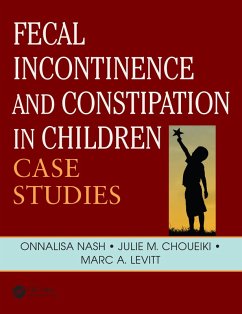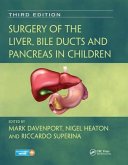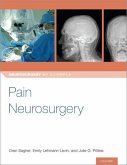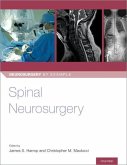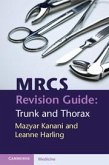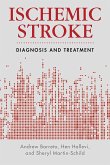Fecal Incontinence and Constipation in Children
Case Studies
Herausgeber: Nash, Onnalisa; Levitt, Marc; Choueiki, Julie
Fecal Incontinence and Constipation in Children
Case Studies
Herausgeber: Nash, Onnalisa; Levitt, Marc; Choueiki, Julie
- Broschiertes Buch
- Merkliste
- Auf die Merkliste
- Bewerten Bewerten
- Teilen
- Produkt teilen
- Produkterinnerung
- Produkterinnerung
Every hospital and children's center encounters children who suffer from fecal incontinence, and treatments may be suboptimal. This book features a case-based approach with reproducible algorithms and examples of x-ray interpretation enabling any clinician to care for children with these problems.
Andere Kunden interessierten sich auch für
![Surgery of the Liver, Bile Ducts and Pancreas in Children Surgery of the Liver, Bile Ducts and Pancreas in Children]() Surgery of the Liver, Bile Ducts and Pancreas in Children130,99 €
Surgery of the Liver, Bile Ducts and Pancreas in Children130,99 €![Pain Neurosurgery Pain Neurosurgery]() Pain Neurosurgery168,99 €
Pain Neurosurgery168,99 €![Spinal Neurosurgery Spinal Neurosurgery]() Spinal Neurosurgery188,99 €
Spinal Neurosurgery188,99 €![Operative Surgery Vivas for the MRCS Operative Surgery Vivas for the MRCS]() Ali AbbassianOperative Surgery Vivas for the MRCS66,99 €
Ali AbbassianOperative Surgery Vivas for the MRCS66,99 €![Catheterization and Interventional Cardiology in Adult Patients Catheterization and Interventional Cardiology in Adult Patients]() Catheterization and Interventional Cardiology in Adult Patients43,99 €
Catheterization and Interventional Cardiology in Adult Patients43,99 €![Mrcs Revision Guide: Trunk and Thorax Mrcs Revision Guide: Trunk and Thorax]() Mazyar KananiMrcs Revision Guide: Trunk and Thorax60,99 €
Mazyar KananiMrcs Revision Guide: Trunk and Thorax60,99 €![Ischemic Stroke: Diagnosis and Treatment Ischemic Stroke: Diagnosis and Treatment]() Ischemic Stroke: Diagnosis and Treatment157,99 €
Ischemic Stroke: Diagnosis and Treatment157,99 €-
-
-
Every hospital and children's center encounters children who suffer from fecal incontinence, and treatments may be suboptimal. This book features a case-based approach with reproducible algorithms and examples of x-ray interpretation enabling any clinician to care for children with these problems.
Hinweis: Dieser Artikel kann nur an eine deutsche Lieferadresse ausgeliefert werden.
Hinweis: Dieser Artikel kann nur an eine deutsche Lieferadresse ausgeliefert werden.
Produktdetails
- Produktdetails
- Verlag: CRC Press
- Seitenzahl: 208
- Erscheinungstermin: 23. September 2019
- Englisch
- Abmessung: 189mm x 245mm x 19mm
- Gewicht: 570g
- ISBN-13: 9780367151614
- ISBN-10: 0367151618
- Artikelnr.: 57673522
- Herstellerkennzeichnung
- Libri GmbH
- Europaallee 1
- 36244 Bad Hersfeld
- gpsr@libri.de
- Verlag: CRC Press
- Seitenzahl: 208
- Erscheinungstermin: 23. September 2019
- Englisch
- Abmessung: 189mm x 245mm x 19mm
- Gewicht: 570g
- ISBN-13: 9780367151614
- ISBN-10: 0367151618
- Artikelnr.: 57673522
- Herstellerkennzeichnung
- Libri GmbH
- Europaallee 1
- 36244 Bad Hersfeld
- gpsr@libri.de
Marc Levitt, MD, is Chief of the Section of Colorectal and Pelvic Reconstruction Surgery at Nationwide Children's Hospital and Professor of Surgery and Pediatrics at the Ohio State University. The Center aligns specialists within GI, Colorectal, Pediatric Surgery, Urology and Gynecology to create a comprehensive treatment program assisting children with these complex disorders. He also serves as the program director for the pediatric colorectal surgery fellowship, and as associate program director for the pediatric surgery fellowship. Dr. Levitt has published more than 200 peer-reviewed articles and 100 book chapters, and has delivered over 300 national/international and 100 local/regional presentations of his work. He recently co-authored Pediatric Colorectal and Pelvic Surgery, Case Studies (CRC Press). He has been an invited visiting professor all over the world, has trained numerous clinical fellows, research fellows, nurses and students and has directed multiple colorectal surgery training courses attended by established surgeons and surgical trainees from all over the world. He dedicates much of his free time to mission trips to the developing world where he trains surgeons and nurses in complex colorectal techniques. Contributors, nursing team: Onnalisa Nash, Kristina Booth, Cheryl Baxter, Andrea Wagner, Meghan Peters and others Onnalisa Nash, is the APN Program Coordinator at the Center for Colorectal and Pelvic Reconstruction, Nationwide Children's Hospital. Julie Choueiki is the Program Manager at the Center for Colorectal and Pelvic Reconstruction, Nationwide Children's Hospital.
PART I: BOWEL MANAGEMENT. General guidelines for bowel management. Bowel
management program setup: The basics and long-term follow-up. PART II:
ANORECTAL MALFORMATIONS. A patient with good surgical anatomy after
anorectal malformation (ARM). repair with good potential for bowel control.
A patient with good surgical anatomy following anorectal malformation
(ARM). repair with fair potential for bowel control. A patient with a well
done anatomic anorectal malformation (ARM) repair, but with poor potential
for bowel control. A patient with a history of a cloacal malformation who
needs colorectal, urological, and gynecological collaboration. A young
adult with prior surgery for anorectal malformation (ARM) with fecal
incontinence. A patient with an anorectal malformation (ARM) with fecal
incontinence. who is a candidate for a sacral nerve stimulator (SNS). PART
III: HIRSCHSPRUNG DISEASE. A patient with good surgical anatomy and
hypomotility after a Hirschsprung pull-through. A patient with good
surgical anatomy and hypermotility after a redo pull-through. for
Hirschsprung disease. An older child with Hirschsprung disease (HD) and
hypomotility. A patient with total colonic Hirschsprung disease and
soiling. A teenager with prior surgery for Hirschsprung disease who has
constipation. PART IV: SPINAL ANOMALIES. A patient with a hypodeveloped
sacrum and fecal and urinary incontinence. A patient with a spinal anomaly
and fecal incontinence. A pediatric patient with spina bifida in need of a
urological reconstruction. A young adult with quadriplegia and fecal
incontinence due to spinal cord injury (SCI). PART V: INTRODUCTION TO
FUNCTIONAL CONSTIPATION. A case of diffuse colonic dysmotility. A patient
with chronic constipation and sphincter dysfunction. A patient with severe
functional constipation, fecal impaction, and no soiling. A patient with
severe functional constipation, fecal impaction, and soiling. Success with
a rectal enema regimen, but now unable to tolerate rectal administration. A
patient with severe functional constipation who has failed laxative
treatment. and both antegrade and rectal enemas. A patient who has
recurrent constipation and soiling following colonic resection. A young
adult with intractable constipation and diffuse colonic dysmotility. An
adult with pelvic floor dyssynergia. A patient with severe constipation and
a behavioral disorder. An adult with incontinence after a low anterior
resection. Two adults with incontinence after childbirth. A young adult
with rectal pain and fecal urgency who is a candidate for sacral. nerve
stimulation. An adult with soiling following an ileoanal pouch. PART VI:
RADIOLOGY. Which X-ray is worse?. Interesting radiological findings. PART
VII: MYTHS. Colorectal surgical myths. PART VIII: MEDICATION PROTOCOLS.
Medication protocols. Index.
management program setup: The basics and long-term follow-up. PART II:
ANORECTAL MALFORMATIONS. A patient with good surgical anatomy after
anorectal malformation (ARM). repair with good potential for bowel control.
A patient with good surgical anatomy following anorectal malformation
(ARM). repair with fair potential for bowel control. A patient with a well
done anatomic anorectal malformation (ARM) repair, but with poor potential
for bowel control. A patient with a history of a cloacal malformation who
needs colorectal, urological, and gynecological collaboration. A young
adult with prior surgery for anorectal malformation (ARM) with fecal
incontinence. A patient with an anorectal malformation (ARM) with fecal
incontinence. who is a candidate for a sacral nerve stimulator (SNS). PART
III: HIRSCHSPRUNG DISEASE. A patient with good surgical anatomy and
hypomotility after a Hirschsprung pull-through. A patient with good
surgical anatomy and hypermotility after a redo pull-through. for
Hirschsprung disease. An older child with Hirschsprung disease (HD) and
hypomotility. A patient with total colonic Hirschsprung disease and
soiling. A teenager with prior surgery for Hirschsprung disease who has
constipation. PART IV: SPINAL ANOMALIES. A patient with a hypodeveloped
sacrum and fecal and urinary incontinence. A patient with a spinal anomaly
and fecal incontinence. A pediatric patient with spina bifida in need of a
urological reconstruction. A young adult with quadriplegia and fecal
incontinence due to spinal cord injury (SCI). PART V: INTRODUCTION TO
FUNCTIONAL CONSTIPATION. A case of diffuse colonic dysmotility. A patient
with chronic constipation and sphincter dysfunction. A patient with severe
functional constipation, fecal impaction, and no soiling. A patient with
severe functional constipation, fecal impaction, and soiling. Success with
a rectal enema regimen, but now unable to tolerate rectal administration. A
patient with severe functional constipation who has failed laxative
treatment. and both antegrade and rectal enemas. A patient who has
recurrent constipation and soiling following colonic resection. A young
adult with intractable constipation and diffuse colonic dysmotility. An
adult with pelvic floor dyssynergia. A patient with severe constipation and
a behavioral disorder. An adult with incontinence after a low anterior
resection. Two adults with incontinence after childbirth. A young adult
with rectal pain and fecal urgency who is a candidate for sacral. nerve
stimulation. An adult with soiling following an ileoanal pouch. PART VI:
RADIOLOGY. Which X-ray is worse?. Interesting radiological findings. PART
VII: MYTHS. Colorectal surgical myths. PART VIII: MEDICATION PROTOCOLS.
Medication protocols. Index.
PART I: BOWEL MANAGEMENT. General guidelines for bowel management. Bowel
management program setup: The basics and long-term follow-up. PART II:
ANORECTAL MALFORMATIONS. A patient with good surgical anatomy after
anorectal malformation (ARM). repair with good potential for bowel control.
A patient with good surgical anatomy following anorectal malformation
(ARM). repair with fair potential for bowel control. A patient with a well
done anatomic anorectal malformation (ARM) repair, but with poor potential
for bowel control. A patient with a history of a cloacal malformation who
needs colorectal, urological, and gynecological collaboration. A young
adult with prior surgery for anorectal malformation (ARM) with fecal
incontinence. A patient with an anorectal malformation (ARM) with fecal
incontinence. who is a candidate for a sacral nerve stimulator (SNS). PART
III: HIRSCHSPRUNG DISEASE. A patient with good surgical anatomy and
hypomotility after a Hirschsprung pull-through. A patient with good
surgical anatomy and hypermotility after a redo pull-through. for
Hirschsprung disease. An older child with Hirschsprung disease (HD) and
hypomotility. A patient with total colonic Hirschsprung disease and
soiling. A teenager with prior surgery for Hirschsprung disease who has
constipation. PART IV: SPINAL ANOMALIES. A patient with a hypodeveloped
sacrum and fecal and urinary incontinence. A patient with a spinal anomaly
and fecal incontinence. A pediatric patient with spina bifida in need of a
urological reconstruction. A young adult with quadriplegia and fecal
incontinence due to spinal cord injury (SCI). PART V: INTRODUCTION TO
FUNCTIONAL CONSTIPATION. A case of diffuse colonic dysmotility. A patient
with chronic constipation and sphincter dysfunction. A patient with severe
functional constipation, fecal impaction, and no soiling. A patient with
severe functional constipation, fecal impaction, and soiling. Success with
a rectal enema regimen, but now unable to tolerate rectal administration. A
patient with severe functional constipation who has failed laxative
treatment. and both antegrade and rectal enemas. A patient who has
recurrent constipation and soiling following colonic resection. A young
adult with intractable constipation and diffuse colonic dysmotility. An
adult with pelvic floor dyssynergia. A patient with severe constipation and
a behavioral disorder. An adult with incontinence after a low anterior
resection. Two adults with incontinence after childbirth. A young adult
with rectal pain and fecal urgency who is a candidate for sacral. nerve
stimulation. An adult with soiling following an ileoanal pouch. PART VI:
RADIOLOGY. Which X-ray is worse?. Interesting radiological findings. PART
VII: MYTHS. Colorectal surgical myths. PART VIII: MEDICATION PROTOCOLS.
Medication protocols. Index.
management program setup: The basics and long-term follow-up. PART II:
ANORECTAL MALFORMATIONS. A patient with good surgical anatomy after
anorectal malformation (ARM). repair with good potential for bowel control.
A patient with good surgical anatomy following anorectal malformation
(ARM). repair with fair potential for bowel control. A patient with a well
done anatomic anorectal malformation (ARM) repair, but with poor potential
for bowel control. A patient with a history of a cloacal malformation who
needs colorectal, urological, and gynecological collaboration. A young
adult with prior surgery for anorectal malformation (ARM) with fecal
incontinence. A patient with an anorectal malformation (ARM) with fecal
incontinence. who is a candidate for a sacral nerve stimulator (SNS). PART
III: HIRSCHSPRUNG DISEASE. A patient with good surgical anatomy and
hypomotility after a Hirschsprung pull-through. A patient with good
surgical anatomy and hypermotility after a redo pull-through. for
Hirschsprung disease. An older child with Hirschsprung disease (HD) and
hypomotility. A patient with total colonic Hirschsprung disease and
soiling. A teenager with prior surgery for Hirschsprung disease who has
constipation. PART IV: SPINAL ANOMALIES. A patient with a hypodeveloped
sacrum and fecal and urinary incontinence. A patient with a spinal anomaly
and fecal incontinence. A pediatric patient with spina bifida in need of a
urological reconstruction. A young adult with quadriplegia and fecal
incontinence due to spinal cord injury (SCI). PART V: INTRODUCTION TO
FUNCTIONAL CONSTIPATION. A case of diffuse colonic dysmotility. A patient
with chronic constipation and sphincter dysfunction. A patient with severe
functional constipation, fecal impaction, and no soiling. A patient with
severe functional constipation, fecal impaction, and soiling. Success with
a rectal enema regimen, but now unable to tolerate rectal administration. A
patient with severe functional constipation who has failed laxative
treatment. and both antegrade and rectal enemas. A patient who has
recurrent constipation and soiling following colonic resection. A young
adult with intractable constipation and diffuse colonic dysmotility. An
adult with pelvic floor dyssynergia. A patient with severe constipation and
a behavioral disorder. An adult with incontinence after a low anterior
resection. Two adults with incontinence after childbirth. A young adult
with rectal pain and fecal urgency who is a candidate for sacral. nerve
stimulation. An adult with soiling following an ileoanal pouch. PART VI:
RADIOLOGY. Which X-ray is worse?. Interesting radiological findings. PART
VII: MYTHS. Colorectal surgical myths. PART VIII: MEDICATION PROTOCOLS.
Medication protocols. Index.

